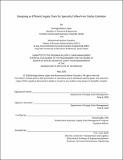| dc.description.abstract | The coffee industry generates annual revenues of approximately US$250 billion, with more than
60 million people depending on it globally. However, coffee farmers in producing countries are operating
at a loss due to selling at low prices to intermediaries who control the downstream channels. Recent
studies highlighted the need to open channels for farmers to access the market of finished products
(roasted coffee). However, most farmers do not have the skills and resources to create these
alternatives. In this research, we develop a cost minimization model that determines the most cost efficient
supply chain network configuration, starting from the farmers in Caldas, Colombia, to the
Northeastern region of the United States. We formulated a MILP network model with a cost
minimization objective. We considered several candidate facilities, transportation modes, and coffee
processing technologies in our model. Our model also considers multiple periods, multiple echelons,
single product, and weight and volume variations along the supply chain. The model was solved for
different demand scenarios and the optimal solution was analyzed for each. The outcome is a better
understanding and a framework of the optimum cost network configuration, which can be implemented
by producers. | en_US |
